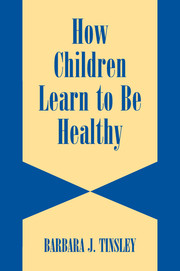Book contents
- Frontmatter
- Contents
- Acknowledgments
- How Children Learn to Be Healthy
- Introduction
- 1 Mechanisms and Consequences of Socializing Children to Be Healthy
- 2 Children's Health Understanding and Behavior
- 3 Parents' Health Beliefs
- 4 Parents' Promotion of Their Children's Health
- 5 Parents' Promotion of Their Children's Sexual Health
- 6 Peers, Schools, and Children's Health
- 7 How Television Viewing and Other Media Use Affect Children's Health
- 8 The Social Ecology of Children's Health Socialization
- 9 Summary and Conclusions
- References
- Index
2 - Children's Health Understanding and Behavior
Published online by Cambridge University Press: 27 July 2009
- Frontmatter
- Contents
- Acknowledgments
- How Children Learn to Be Healthy
- Introduction
- 1 Mechanisms and Consequences of Socializing Children to Be Healthy
- 2 Children's Health Understanding and Behavior
- 3 Parents' Health Beliefs
- 4 Parents' Promotion of Their Children's Health
- 5 Parents' Promotion of Their Children's Sexual Health
- 6 Peers, Schools, and Children's Health
- 7 How Television Viewing and Other Media Use Affect Children's Health
- 8 The Social Ecology of Children's Health Socialization
- 9 Summary and Conclusions
- References
- Index
Summary
Children's Understanding of Health
Children's understanding of and attitudes toward health are usually conceptualized in one of two ways. The first is a focus on children's understanding of health-related concepts, including the causes of illness, health knowledge, and other related issues. These can be characterized as reflecting the cognitive-structural tradition, as exemplified by Piaget. This work focuses on age-related normative changes in children's attitudes and ideas. The second perspective considers children's health attitudes and behavior from an individual differences perspective.
Children's Understanding of Health-Related Concepts: Stage Theory
With respect to children's attitudes about health, several domains have been the subject of investigation. These include children's ideas, knowledge, and understanding of health and illness. Gellert (1962) found developmental trends in children's understanding of how their bodies work, with children 9 years of age and older able to describe body systems and their permanence.
Several investigations have been focused on children's developmental ideas about health and illness. Rashkis (1965), in a sample of hospitalized 4- to 8-year-olds, found that the older children were more likely to equate being well with positive attributions than were the younger children. Moreover, all of these children, but especially the older group, believed that physicians, not their parents, were to be held responsible for their health status. The usefulness of this study is limited, however, because the children were hospitalized during the interviews.
Other studies have utilized Piagetian concepts in order to analyze children's systematic understanding of health and illness.
- Type
- Chapter
- Information
- How Children Learn to be Healthy , pp. 11 - 26Publisher: Cambridge University PressPrint publication year: 2002



